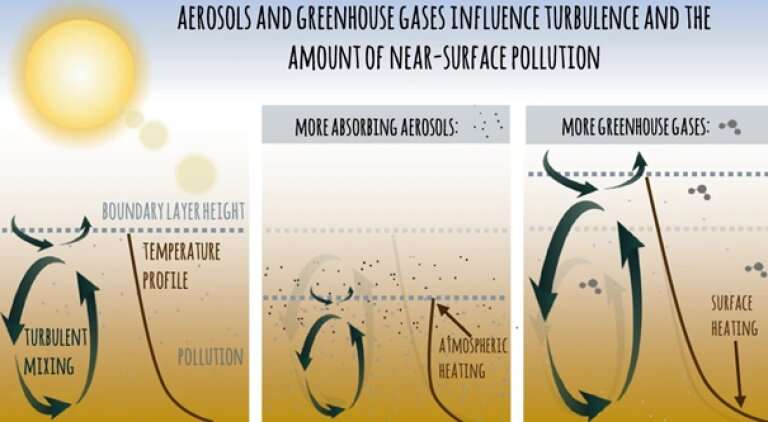This article has been reviewed according to Science X's editorial process and policies. Editors have highlighted the following attributes while ensuring the content's credibility:
fact-checked
peer-reviewed publication
proofread
In the future, an increase in turbulence could alleviate the intensity of near-surface air pollution

Near-surface air pollution is a serious health hazard estimated to cause millions of deaths annually. Soot, emitted for instance from coal burning or from motor vehicles, is one such pollutant.
"The amount of pollution we are exposed to is first and foremost controlled by the level of emissions. However, meteorological conditions such as the presence of rain or the amount of turbulence can cause either dilution or accumulation of the emitted pollutants. Turbulence acts as an important transporter of pollutants away from the surface," explained senior researcher Camilla Stjern at CICERO Center for International Climate Research who is the lead author of the new study published in Nature Communications.
In the study, the researchers used an ensemble of existing global climate model simulations as well as dedicated model experiments and build on established findings showing a link between soot emissions and reduced turbulence in the lower levels of the atmosphere.
High emission of soot cause reduced turbulence
Sometimes the air is very stable, there is very little turbulence, and we can experience the kind of episodes we typically see during winter, where the air (and the pollution in it) lies as a shallow lid over the surface causing severe air pollution episodes. Recent findings indicate the existence of an effect where high emissions of soot cause reduced turbulence in the lower atmosphere. This happens because the dark soot particles absorb solar radiation, warming the surrounding air and making it more stable and stagnant. This lowers the efficiency of turbulence-driven ventilation of pollution out of the planetary boundary layer, increasing the number of such severe pollution events.
In the present study, CICERO researchers have looked closer into the link between turbulence and pollution—looking both backward in time and into the future.
"In this study we show that more than 80% of the world's population live in areas that have seen a reduction in turbulence over the historical period. However, we find that in the future we are likely to see an increase in turbulence," said senior researcher at CICERO Øivind Hodnebrog who is co-author of the study.
Cutting soot emission gives added benefits for health
Projected reductions of soot emissions in the future will cause an increase in turbulence that will alleviate the harmful effects of aerosol pollution on human health. But future emission trends are large and uncertain, particularly in Asia, and the number of people in polluted areas that will experience an increase in turbulence depends crucially on the exact emission pathways.
"The results from our study underline the importance of reducing soot emission in order to reduce intense near-surface air pollution of all kinds," explained Stjern.
Hopefully, the problems of aerosol pollution will eventually be alleviated in all regions of the globe, at which point the added impact of changes in turbulence is of little importance. In the meantime, air pollution is estimated to cause millions of deaths every year. And mitigations in the future do not necessarily provide instant relief as the number of people exposed to pollution-driven health risk is a function not only of emission levels, but also of demographic and socioeconomic factors.
For instance, others have found that excess deaths from pollution in India are expected to increase towards 2100, due to demographic transitions involving population growth as well as a shift towards an older population.
Ultimately, exposure to air pollution depends on a myriad of factors and is likely to continue to be an issue even as emissions go down. The way anthropogenic emissions interact with turbulence and feedback on the level of near-surface air pollution is one such factor, and one that is likely to contribute with a positive sign in the future.
"It doesn't happen too often that climate researchers can provide positive messages, but this analysis allows us to do just that: in the future when emissions go down, the turbulence will be stronger and the air fresher," said Camilla Stjern.
More information: Camilla W. Stjern et al, The turbulent future brings a breath of fresh air, Nature Communications (2023). DOI: 10.1038/s41467-023-39298-4
Journal information: Nature Communications
Provided by Centre for International Climate and Environmental Research (CICERO)





















